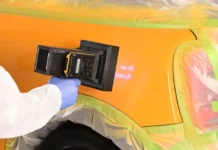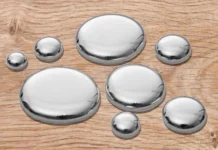By Yung-Chi Yang, Pei-Yun Lee and Dr. Yao-Hsing Huang, Specialty Chemical Business Unit, Everlight Chemical Industrial Corp.
Abstract
Waterborne UV-curable coatings have been developed to replace conventional UV-curable coatings to lower volatile organic compound (VOC) content. Due to fast drying and short processing time, UV-curable coatings are widely used in various industries. However, there are two major challenges: discoloration after long-term exposure to sunlight and UV filtering ability, since waterborne UV-curable coatings are usually applied to the surface as a protection topcoat.
The novel light stabilizer (NLS) is developed specifically for waterborne UV-curable coatings. Design of Experiment (DOE) was used in the study. Test data show that the designed NLS would not interfere with the curing speed of the tested clear waterborne UV-curable coating system. Moreover, the results confirmed that increasing the concentration of NLS could enhance the UV filtering ability and weatherability of the tested clear topcoat more effectively than increasing the coating thickness. At 365 nm wavelength, the effect factor of NLS is 62.5%, while the effect factor of DFT (dry film thickness) is 20.9%; at 380 nm, the effect factor of NLS is 47.7%, while the effect factor of DFT is only 27.4%. Test results confirmed the designed NLS could block the UV without compromising the UV curing speed, making it suitable for enhancing the weatherability and protection ability of clear waterborne UV-curable coatings.
Introduction
UV curing is a photochemical process that offers higher production efficiency, compared to traditional drying methods, and is widely used in such industries as packaging, printing inks and various protective coatings for wood, plastics, metal, etc. [1] Among different UV-curable resins, waterborne UV-curable resin combines the advantages of both UV curing and the waterborne system, offering a viable option for eco-friendly coatings with low VOCs, nontoxicity and fast processing time. However, there are still challenges in using waterborne UV-curable coatings:
- discoloration after long-term exposure to ultraviolet light, which leads to degradation of the coating layer
- instant yellowing during the UV curing process, which causes appearance and quality concerns, and
- the protection requirement for near-visible light-sensitive materials.
To solve the above-mentioned challenges, usually UV absorbers (UVA) and hinder amine light stabilizers (HALS) are used.
UV absorbers will absorb UV energy to protect the polymer from degradation. However, in the UV curing process, photoinitiators are used, with UV energy required to initiate the curing reaction. As the result, the UV absorber and photoinitiator compete for UV energy, negatively impacting curing speed and production efficiency.
A novel light stabilizer (NLS) is rolled out to meet the challenges above [11-16]. The objectives of this article are to demonstrate a recent development in liquid NLS especially designed for waterborne UV-curable coating systems and to effectively enhance weatherability without sacrificing curing speed.
Experiment
Materials
- Waterborne UV-curable polyurethane (Bayhydrol® UV 2282), Industrial Grade, Bayer
- Photoinitiator (Omnirad®500), Industrial Grade, IGM Resins (formerly Irgacure® 500 by BASF)
- Novel Light Stabilizer Blend (NLS), Industrial Grade, Everlight Chemical
- Waterborne UV Absorber, Waterborne HALS, Industrial Grade, Everlight Chemical
Equipment
- UV Curing Drying Equipment: C Sun / UV-201M
- High-Energy UV Integrating Radiometer: EIT / Model: UVICURE Plus® PLUS-365;
- QUV Accelerated Weathering Tester: Q Panel / Model: QUV Basic
- Spectrophotometer: KONICA MINOLTA / Model: CM-3500d
Methods
- Design of Experiment (DOE) was used to design test runs as well as to analyze the data.
- Waterborne UV-curable coating preparation and UV curing process: waterborne UV-curable coating formulation is shown in Table 1. The blended waterborne UV-curable coating was mixed with different types and doses of light stabilizers (Tables 2 and 3). A film coater was used to evenly apply the mixed blend onto a tinplate or glass plate 10 cm × 7 cm × 0.1 cm in size. The coated plate was placed in a 60℃ oven for 2 mins, then transferred into the UV curing drying machine for the curing process.
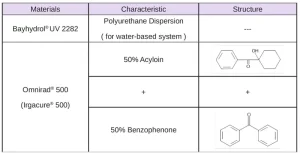

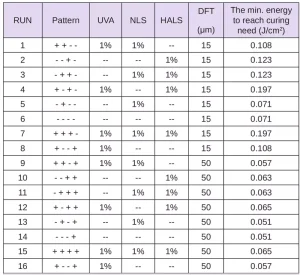
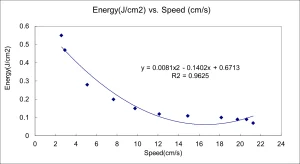
- Minimum Required Energy Test: The high-energy UV integrating radiometer was used to monitor the minimum energy required to complete the curing process on the tested sample. A wire-wound rod (WWR) was used to apply the tested coatings on Leneta Charts, and the tested sample was cured under 1 x 150 W/cm high-pressure Hg lamp. The cured-completion speed was recorded with no visible marks on the coating surface caused by fingernail-scratching. Figure 1 illustrates UV energy (J/cm2) delivered to the coating surface as a function of the conveyer belt speed (cm/s). Coatings receive less UV energy at higher belt speeds, but the correlation between energy delivered and belt speed is nonlinear. If the coating could be cured at low energies, it represents a highly efficient production process.
- Accelerated weathering test: ASTM G154-1 (2006 version). Test standard: 340 nm, 60℃, 8 hrs / 50℃, 4 hrs cool down)
- Testing method for blocking efficiency of wavelength at 365 nm and 380 nm: A spectrophotometer was used to monitor the blocking status of 365 nm or 380 nm during the accelerated weathering test.
- Software and analysis: JMP version 5.0 (SAS Institute)
Results and Discussion
Screening Design
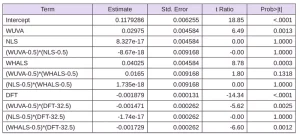
Screening design (Table 3) was used to identify factors that affect the curing speed of waterborne UV-curable coatings. The mathematical model derived from data (Tables 4 and 5) indicates all factors –waterborne UVA, HALS, NLS and film thickness – exhibit some degrees of influence to the curing speed.
Effects of waterborne UV absorber
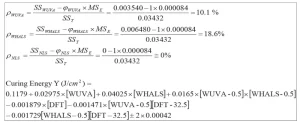
The photoinitiator absorbs UV energy to initiate the curing processes. UV absorber (UVA) absorbs UV energy to prevent coatings from UV degradation. UV absorbers and photoinitiators compete for UV energy and, therefore, negatively impact curing speed. Our experiment results match the assumption mentioned previously. The model derived from data confirms the waterborne UV absorber is a significant factor that causes curing speed to drop considerably. For UVA, the effect factor of curing energy is about 10.1% (Figure 2).
Effects of waterborne HALS
Although HALS functionally don’t absorb UV light, surprisingly they exhibit the highest negative impact on curing speed among all the factors. One possible reason is the fact that HALS are effective free radical scavengers, possibly interfering with the free radical chain reaction initiated by photoinitiators and leading to premature termination of the curing process and an incompletely cured coating layer. As a result, for HALS, the effect factor for curing energy is about 18.6% – higher than that of UVA (Figure 2).
Effects of film thickness

Film thickness is the least significant factor in this study (Figure 2). Its negative coefficient is in agreement with a known fact to the industry: In the free radical polymerization mechanism, oxygen inhibition affects thinner film more than thicker film. Moreover, a positive coefficient in the model (0.1179) indicates oxygen inhibition did occur to the coatings (Figure 2).
Effects of novel light stabilizer (NLS)
NLS is developed specifically for a waterborne UV-curable coating system. Test data show that NLS added in the waterborne UV-curable clear coating would not interfere with curing speed. For NLS, the effect factor of curing energy is about 0% (Figure 2).
Evaluation of optimized situation
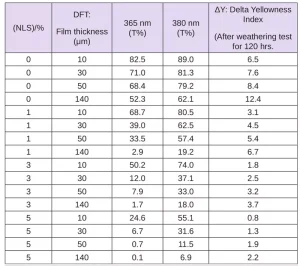
Evaluations of optimized situation tests and results are shown in Table 6. The evaluation identifies the effect of NLS (novel light stabilizer) concentration and DFT (dry film thickness), factors that affect UV filtering ability at 365 nm, 380 nm wavelength and the yellowing status after weathering for 120 hours. The mathematical model derived from data indicates two factors – NLS and DFT – exhibit some degree of influence on UV filtering and yellowing after the weathering test.
Effects of novel light stabilizer (NLS) and film thickness on 365 nm UV filtering

NLS is developed specifically for waterborne UV-curable coatings. According to the results analyzed from Tables 6 through 8 and Figure 2, the effect factor of NLS on 365 nm UV filtering is 62.5%. For film thickness, the effect factor is only 20.9%. The result indicates that increasing NLS concentration in waterborne clear coatings will have better 365 nm UV filtering efficiency compared with increasing film thickness (Figure 3).
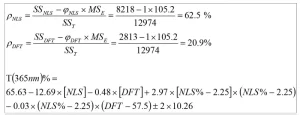
Effects of novel light stabilizer (NLS) and film thickness on 380 nm UV filtering

The UV filtering at 380 nm shows the same trend as at 365 nm. For NLS, the effect factor on 380 nm UV filtering is 47.7%. For film thickness, the effect factor is only 27.4% (Figure 4). The effect factor of NLS concentration is stronger than film thickness. To improve UV filtering performance at 380 nm, increasing NLS concentration is more effective than increasing film thickness.
Effects of NLS and film thickness on yellowing
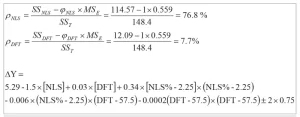
The effects of NLS and film thickness to reduce yellowing were evaluated. For NLS, the effect factor of reducing yellowing is 76.8%, while for film thickness, the effect factor is only 7.7% (Figure 5). The results show that, compared with film thickness, NLS concentration used in waterborne clearcoats is the dominant factor for yellowing.
The optimal prediction profiler
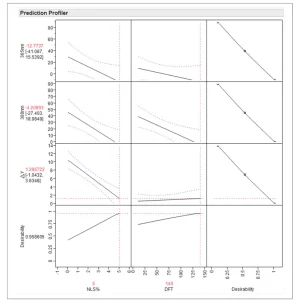
The optimal prediction profiler shows effects of NLS and DFT on UV filtering at 365 nm, 380 nm and yellowing difference after weathering for 120 hours. The results suggest the best condition of NLS concentration is 5% and film thickness is 140 μm (Figure 6).
Response surface methodology (RSM)
Response surface methodology (RSM) is a collection of mathematical and statistical techniques for empirical model building. By careful design of experiments, the objective is to optimize a response (output variables are 365 nm, 380 nm and ΔY) influenced by several independent variables [input variables are NLS (%) and DFT (μm)]. The highlighted area from this model is the optimal result in UV filtering at 365 nm, 380 nm and reduced yellowing (Figures 7 through 9).




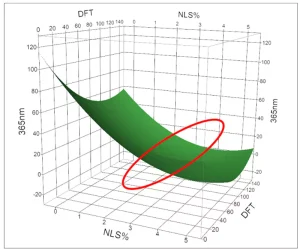
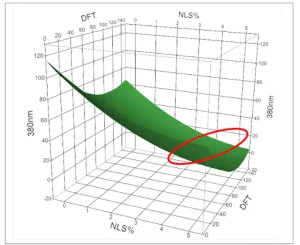
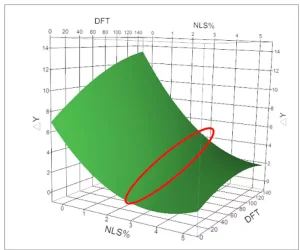
Conclusion
Eco-friendly coatings are among the most important development trends in the coating industry. In this article, we demonstrated the benefits of using the novel light stabilizer (NLS) in a waterborne UV-curable coating system.
The test results show that the designed NLS would not interfere with the curing speed of the tested waterborne UV-curable clear coating and, therefore, won’t have a negative impact on the curing process. Moreover, the result confirms that increasing the NLS concentration in the clearcoat provides higher efficiency in enhancing the UV filtering ability, as compared with increasing film thickness. At 365 nm wavelength, the effect factor of NLS is 62.5%, while DFT (dry film thickness) is 20.9%. At 380 nm, the effect factor of NLS is 47.7%, while DFT is only 27.4%. For NLS, the effect factor of reducing yellowing is 76.8%. For film thickness, the effect factor is only 7.7%.
Our test results prove the designed NLS could block UV without compromising curing speed and provides a solution for enhancing weatherability of waterborne UV-curable coatings. Coating manufacturers may still need to replicate experiments to confirm compatibility. A customized UV absorber and light stabilizer package could be tailored to fulfill special needs.
References
- Fouassier J P, Rabek J F. Radiation Curing in Polymer Science and Technology [M]. Vol. 1. New York: Elsevier Applied Science, 1993: 1-47.
- MIN-HEE LEEA, HEE-YOUNG CHOIA, KIE-YOUN-JEONGBb, JUNG-WOOK LEEB, TAE-WON HWANG, BYUNG-KYU KIMA, High performance UV cured polyurethane dispersion [J]. Polymer Degradation Stability, 2007(92): 1677-1681.
- WOOD K A. Waterborne radiation curable coating for wood[J]. Polymers Paint Colour Journal, 1993, 183(4334):34.
- GARRATT P G, KLMESCH K F. Radiation curable waterborne coating [J]. Polymers Paint Colour Journal, 1994, 184(4334):30-32.
- JOHANSSON M, GLAUSER T, JANSSON, et al. Design of coating resins by changing the architecture: solid and liquid coating systems [J]. Progress in Organic Coatings, 2003, 48(2):194-200.
- DECKER C, MASSON F, SCHWALM R. How to speed up the UV curing of water-based acrylic coatings [J]. Journal of Coatings Technology and Research, 2004, 1(2): 127-136.
- Sow C., Riedl B., Blanchet P.: Kinetic studies of UV waterborne nanocomposite formulations with nanoalumina and nanosilica [J]. Progress in Organic Coatings, 2010, 67:188–194.
- CHENYAN BAI, FRANK ZHANG. Waterborne UV-curable PU coatings for interior and exterior wood applications [J]. Asia Pacific Coatings Journal, 2011, 24(05):37-38.
- HUANG PING, YE DAIYONG. Effect of C=C double bond on the properties of waterborne UV PUD [J]. Paint & Coatings Industry, 2011, 41(10): 48-53.9
- Z. H. Fang, J. J. Shang, Y. X. Huang, J. Wang, D. Q. Li, Z. Y. Liu. Preparation and characterization of the heat-resistant UV curable waterborne polyurethane coating modified by bisphenol A [J]. Express Polymer Letters, 2010, 4(11): 704-711
- YUNG-CHI YANG, YU-SHU SUNG, CHIN-HSIEN CHEIN, YAO-HSING HUANG. Novel light stabilizers for waterborne UV-curable coatings [J]. Polymers Paint Colour Journal, 2013, 203(4583):13-15.
- YUNG-CHI YANG, LAI MING-HUA, SUNG YU-SHU, LAI YIN-TING, CHIOU SHIAN-FANG, CHEIN CHIN-HSIEN, YAO-HSING HUANG. Light stabilizers make the UV protection of waterborne UV-curable coatings easier [J]. Coatings World, 2014, 19(6): 38-40
- YUNG-CHI YANG, LAI MING-HUA, SUNG YU-SHU, LAI YIN-TING, CHIOU SHIAN-FANG, CHEIN CHIN-HSIEN, YAO-HSING HUANG. Less yellowing in uv coat [J]. European Coating Journal, 2017(4): 136-140
- YAO-HSING HUANG, YUNG-CHI YANG. Light stabilisers for clear coatings [J]. Polymers Paint Colour Journal, 2010, 200(4544):38.
- YUNG-CHI YANG, YU-SHU SUNG, CHIN-HSIEN CHEIN, YAO-HSING HUANG. Light stabilisers for environmentally friendly coatings[J]. Polymers Paint Colour Journal, 2012, 202(4571):16-18.
- YUNG-CHI YANG, STEVEN LEE, YAO-HSING HUANG. Light stabilizers make the UV protection of environmentally friendly coatings easier [J]. Coatings World, 2012, 17(4):83-85.



